Students overwhelmingly want mastery-based learning practices in their computing classrooms.
For many students, learning to code can be frustrating, with complicated concepts and technical jargon making it challenging to grasp new ideas. Adopting mastery-based learning practices in computing courses in computing courses can help students develop a deeper understanding of the material, reduce frustration, and improve their learning outcomes.
To better understand student perceptions of mastery-based learning practices in computing classrooms, we surveyed 193 learners who had taken at least one computing course in the last five years. Below is a summary of our findings, and you can read the full paper here.
We asked respondents about their familiarity and experience with nine mastery-based practices that can be assigned to one of the following four categories:
- Course Learning Goals & Grades
- Feedback Beyond Grades
- Student Practice
- Sequencing and Pacing
 We found that mastery-based learning practices are common in computing classrooms—over 63% of respondents reported seeing it in at least some of their computing courses for each of the nine mastery-based methods we asked about.
We found that mastery-based learning practices are common in computing classrooms—over 63% of respondents reported seeing it in at least some of their computing courses for each of the nine mastery-based methods we asked about.
Additionally, students overwhelmingly want mastery-based learning practices in their computing classrooms. For each mastery-based practice, we asked about, over 78% of respondents would like to see it in future computing courses.
Respondent Demographics
Based on the first chart below, our dataset represents computing students poorly. Lunn Zahedi, Ross, and Ohland (2021) reported that:
“Although women represent 50.8% of the general population in the U.S., in computing their enrollment is far lower. White women in computing tend to have the highest enrollments relative to other racial/ethnic backgrounds, yet they only accounted for 19.7% of the total computing population at its highest (in 1987), and they continued to diminish thereafter, reaching their lowest levels at 7.6% in 2018.”
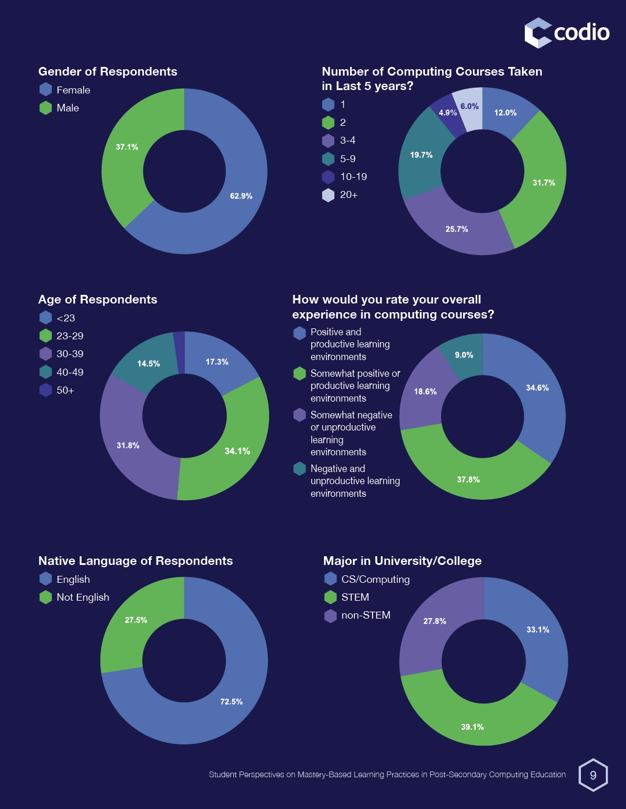
In contrast, almost 63% of our respondents self-reported as female. However, a recent phenomenon of introductory computing courses being adopted as general education requirements means that many computing students are non-majors.
We see this trend reflected in our respondent’s reported majors, which we categorized as CS/ Computing, STEM, and non-STEM, with only a third reporting a CS or Computing major such as Computer Engineering, Web Development, and Information Technology.
This surge in non-majors is also reflected in the number of computing courses taken, indicating that 43.7% have taken only one or two computing courses.
The large proportion of non-majors could explain our high percentage of female respondents and also a large number of non-native English speakers (27.5%), which has only recently started to be discussed in computing education research literature (Lei and Allen 2022). Interestingly, most respondents would be considered non-traditional students (22+ years old).
Course Learning Goals and Grades
Mastery-based learning incorporates clear and measurable learning objectives aligned with the grading scheme. While most courses have stated learning objectives, over 15% of courses discuss them only once or never.
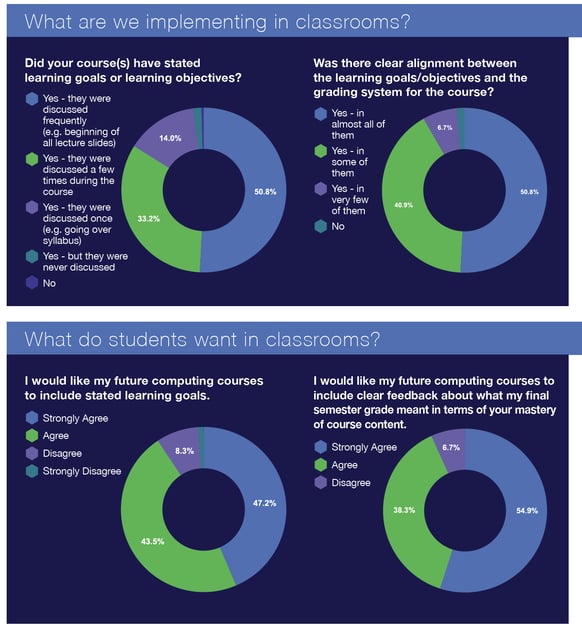
Discussing and referencing frequently throughout the course ensures students understand the importance of learning goals. Clear alignment between learning goals and grading can improve student learning outcomes, but only 50.8% of students agree that almost all of their computing courses have this alignment.
Feedback Beyond Grades
In addition to grades, students need clear and frequent feedback on their progress toward mastering course content. However, only 36.3% of students received clear feedback on their overall semester grade in terms of mastery of course content or, in other words, input on what their grade meant.
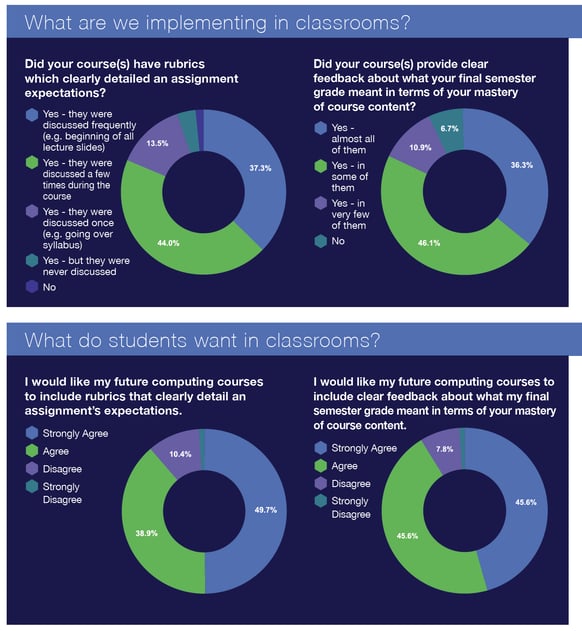
Detailed assignment rubrics can improve learning outcomes, but over 17% of courses discuss them only once or never. Rubrics do not have to be complicated—they can be constructed more as descriptions of what it looks like when learning objectives are met. Thus, by giving rich feedback beyond a mere grade, educators can enhance student understanding of course content and increase engagement.
Student Practice
Giving students opportunities to practice skills and receive feedback before completing graded assignments is another crucial component of mastery-based learning. Although 83.9% of students reported having this opportunity in at least some of their computing courses, only 40.9% reported it in almost all their courses.
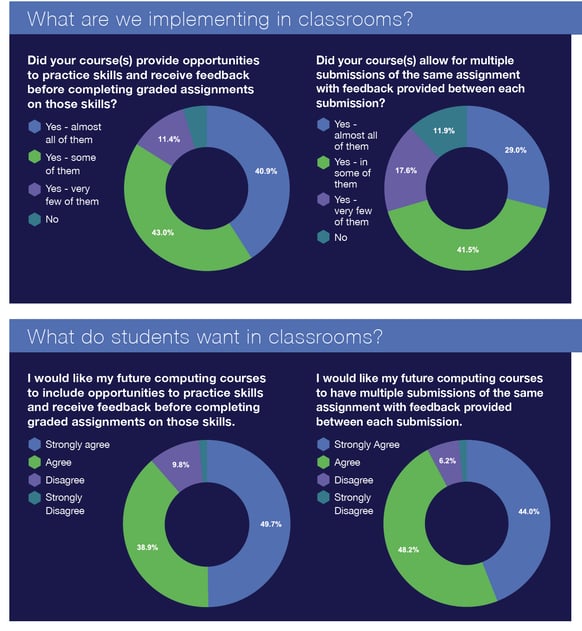
Providing ungraded practice with feedback was ranked as the most likely practice to improve a student’s learning experience and increase engagement. Multiple submissions of the same assignment with feedback was also identified as a desirable practice but had a low adoption rate due to the challenges of providing feedback at scale.
Sequencing and Pacing
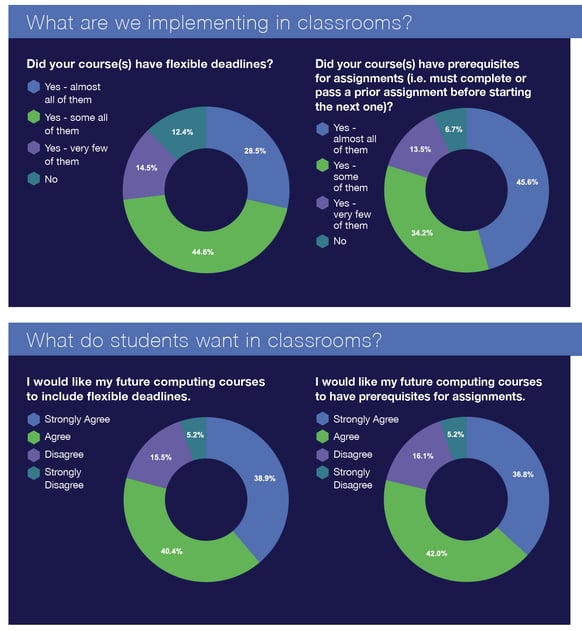 Flexible deadlines and prerequisite assignments can also improve student learning outcomes. However, while 73.1% of respondents reported having flexible deadlines in at least some of their courses, only 79.3% of students reported wanting flexible deadlines in future computing courses.
Flexible deadlines and prerequisite assignments can also improve student learning outcomes. However, while 73.1% of respondents reported having flexible deadlines in at least some of their courses, only 79.3% of students reported wanting flexible deadlines in future computing courses. 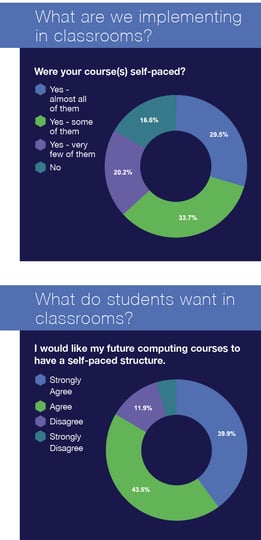
On the other hand, self-paced courses were the least adopted mastery practice, with only 63.2% of respondents having at least some self-paced courses. Providing more structure in self-paced courses and sourcing human hours for feedback could help to address the challenges associated with these practices.
Conclusion
Mastery-based learning practices can improve student learning outcomes in computing education. While some of these practices are already in use in many courses, there is room for improvement in areas such as the alignment between learning goals and grading and providing feedback beyond grades.
Nevertheless, by adopting these strategies, educators can help to make computing education a more positive and productive learning experience for students.
References
Lei, Y., & Allen, M. (2022, February). English Language Learners in Computer Science Education: A Scoping Review. In Proceedings of the 53rd ACM Technical Symposium on Computer Science Education V. 1 (pp. 57-63).
Lunn, S., Zahedi, L., Ross, M., & Ohland, M. (2021). Exploration of intersectionality and computer science demographics: Understanding the historical context of shifts in participation. ACM Transactions on Computing Education (TOCE), 21(2), 1-30.

